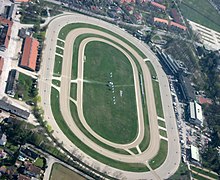Daglfing trotting track
The Daglfing trotting track is a sports facility used for trotting in the Daglfing district of the Bavarian capital, Munich .
description
The trotting track consists of three nested ovals. The outer track, the actual racetrack, is 1000 m long and is used on a left course. The middle track, which serves as a training track, is 800 m long, the inner slow lane 600 m.
At the racetrack there is a three-story grandstand house with 660 seats and a two-story grandstand house with 450 seats. Both grandstand houses have betting halls and restaurants.
history
The first trotting rides in Munich took place in 1867 on the Theresienwiese . Between 1887 and 1898 a trotting track was operated in Laim , but it became inadequate after trotting had gained popularity. Trotting enthusiasts therefore founded the Munich Trotting and Breeding Club and a terrestrial society in 1902 to acquire the site in Daglfing. The railway was opened in October of the same year in the presence of the Crown Prince and later King of Bavaria, Ludwig .
From 1906 racing bets could be accepted; In the years that followed, until it was incorporated into Munich in 1930, the tax to be paid by the Trabrennbahn was the main source of income for the municipality of Daglfing . In 1909 a second grandstand was built for 1000 spectators. Racing was restricted during the First World War , but not given up. During the Munich Soviet Republic in 1919, the trotting facility was briefly occupied by Spartacists - equestrian sport was the domain of the nobility and the well-off bourgeoisie. In the times of crisis in the 1920s, greyhound races , car races and motorcycle races also took place on the track . In the 1930s, when sport was heavily promoted by the National Socialist regime , a lighting system that made evening races possible and a new restaurant were built. The "Silver Horse of Germany", advertised from 1937, was designed as an international trotting award. In April 1938 the main stand was destroyed by fire.
After the Second World War , harness racing quickly took off in Daglfing, and new grandstands were opened in 1951 and 1975. From the 1980s, however, the trotting track in Daglfing ran into financial difficulties, which in 2005 led to the sale of the facility to the Karl group of companies ; a move of the harness racing company to Maisach is under discussion.
In 2016, after years of legal dispute, the construction company and the trotting club agreed that the trotters could use the track in Daglfing until at least 2022, but probably until 2025. The association receives 3.8 million euros from the construction company and is discharged by the construction company. At the same time, the construction company now only undertakes to build a 1000-meter-long track, whereas the trotting club would have to provide the property.
See also
literature
- Klaus Fischer: The trotting track . In: Willibald Karl (Ed.): Villages on the Ziegelland - Daglfing-Denning-Englschalking-Johanneskirchen-Zamdorf . Buchendorfer, Munich 2002, ISBN 978-3-934036-90-1 .
Web links
- Trabrennbahn Daglfing on the website of the Association for District Culture in the Munich Northeast eV
- Münchner Trabrenn- und Zuchtverein eV (official website)
Individual evidence
- ↑ Daglfing - structural concept presented. Financial difficulties: Trotting track has to give way . Münchner Wochenanzeiger from August 26, 2008, accessed on July 21, 2009
- ↑ Trotting track hangs in the air. merkur.de, December 9, 2016, accessed on July 12, 2017 .
Coordinates: 48 ° 8 ′ 36 ″ N , 11 ° 39 ′ 27 ″ E
